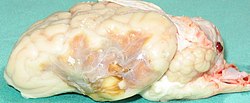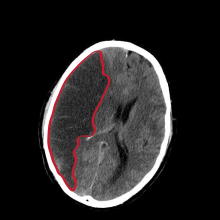Media infarction
| Classification according to ICD-10 | |
|---|---|
| I63 | stroke |
| ICD-10 online (WHO version 2019) | |
As Media infarction is a very localized form of ischemic stroke called (cerebral infarction). The term refers to an occlusion of one of the main vessels in the brain , the arteria cerebri media ("middle cerebral artery"). About 50% of cerebral infarctions are in the supply area of the arteria cerebri media.
root cause
The media infarction is usually an embolic occlusion of the A. cerebri media. This form of ischemic stroke is one of the most common because the middle cerebral artery is the direct continuation of the internal carotid artery . Bleeding and inflammatory processes are also possible .
Risk factors are underlying diseases such as diabetes mellitus , arteriosclerosis and arterial hypertension . Embolisms from the heart , e.g. B. in atrial fibrillation ( cardiac embolism ).
classification
A rough distinction is made between complete media infarction and partial media infarction . A special form is the malignant media infarction , which can arise from large media infarctions. It is characterized by a life-threatening increase in intracranial pressure , which is caused by the infarct edema occurring 2–5 days after the infarct event .
Disease emergence
The occlusion causes ischemia of the underlying tissue . The result is the death of the nerve cells with permanent physical damage, as submerged nerve cells are not replaced. A heart attack is always a tissue breakdown. A temporary occlusion or narrowing, whereby the symptoms subside within an hour, is called a transient ischemic attack (TIA for short).
Clinical manifestations
Since the supply area of the A. cerebri media includes the capsula interna , almost all motor and sensory deficits that make up the clinical picture of a stroke are possible in a media infarction . In addition, paresis , aphasia and sensitive disorders can occur. As a rule, the symptoms always occur on the opposite side of the hemisphere from which the infarct occurs, as the fibrous tracts of the internal capsule cross.
If a cerebral infarction is acquired in early childhood or prenatal , it can lead to bony changes in the brain and facial skull, the Dyke-Davidoff-Masson syndrome .
therapy
After bleeding has been ruled out by means of computed tomography and other contraindications have been ruled out , rapid lysis therapy is sought if the time interval between the onset of symptoms and the start of therapy is no longer than 4.5 hours. In principle, the patient should be treated as quickly as possible in a hospital with a stroke unit . There is also the option of treating a cerebral infarction using an interventional procedure.
Individual evidence
- ↑ Claudio L. Basetti, Dirk M. Herrmann: Clinical symptoms and syndromes in vascular neurology In: Dirk M. Hermann, Thorsten Steiner, Hans C. Diener: Vascular neurology: cerebral ischemias, hemorrhages, vascular malformations, vasculitides and vascular dementia. Thieme-Verlag, 1st edition, June 2010. ISBN 978-3-13-146111-7 , p. 19

